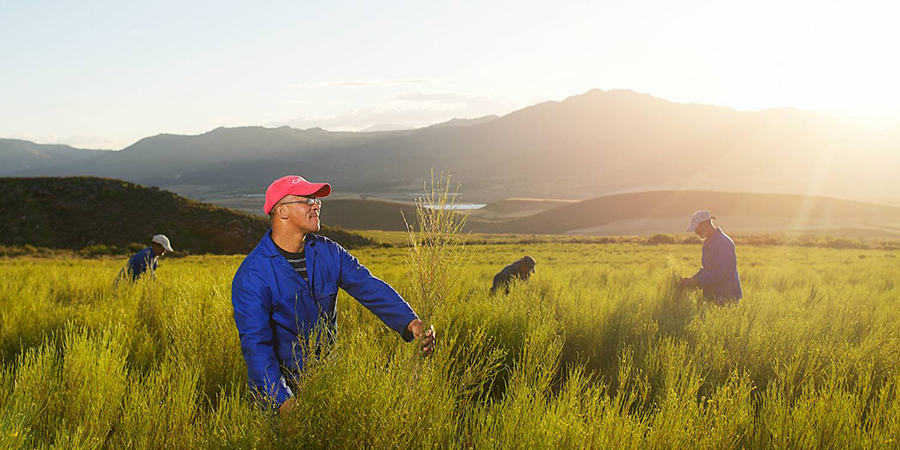Rooibos Crop to Cup
Rooibos Crop to Cup
THE ROOIBOS PLANT
The botanical (scientific) name for the rooibos plant is Aspalathus linearis. The plant (and the products made from it) is widely known as rooibos (pronounced ROI-BOSS). In some countries it is also called ‘redbush’ or ‘African red tea’. Rooibos is a fynbos species within the Cape Floral Kingdom, one of only six recognised floral kingdoms of the world and is unique to the Western Cape Region of South Africa.
THE SEEDS
Rooibos seeds are sown between February to March and the seedlings transplanted a few months later. It takes about 18 months before plants can be harvested for the first time. Each spring the plant is covered with small yellow flowers. Each flower produces a small legume with a single seed inside. The Rooibos seeds pop out when they are ripe and can therefore be difficult to collect. Early Rooibos farmers got hold of the local wisdom that ants harvested the seeds and that they could collect Rooibos seeds from anthills. Today, most farmers collect the seeds by sifting the sand around the plants.
HARVESTING
The rooibos crop is harvested once a year during summer and early autumn by cutting of the branches 50 cm above the ground. Branches are cut and bound into sheaves & transported to the drying yard.
CUTTING
The sheaves are machine-cut to uniform lengths of between 1.5 mm and 5 mm. Cuttings are bruised to facilitate the natural plant phenolic activities which develop the characteristic colour and flavour of this tea, hence the name rooibos (Red Bush).
FERMENTATION
After watering and airing, the tea is left to “sweat” or ferment in heaps. Temperature during sweating 34°C – 38°C for 10 – 14 hours. The “fermentation” process involves oxidation, brought about by enzymes naturally present in the plant. During this process the product changes from green to a deep amber colour and develops its distinctive aroma.
UNFERMENTED/GREEN ROOIBOS
Green rooibos is made from the same plant as traditional rooibos, the only difference is in the processing. For traditional rooibos, the green leaves and stems of the plant are crushed and “fermented” before drying. The fermentation step is actually an oxidation process brought about by enzymes and chemicals naturally present in the plant. In the case of green rooibos, the fermentation process is skipped, and the “green” leaves and stems are dried directly. Different processes are used to prevent oxidation.
Green (unfermented) rooibos infusion has a lighter tan/yellow colour and a very mild “green” taste reminiscent of green tea.
DRYING
After the sweating process, the tea is sun-dried before being sorted and graded according to length, colour, flavour and taste.
STERILISATION
After sifting, the tea is sterilised through steam pasteurisation and dried over hot air beds. The steam temperature during pasteurisation is 135°C and the product temperature is 94°C for a minimum of 90 seconds. All rooibos, whether for domestic use or the export market, is steam pasteurized to ensure a product of high microbial quality.
GRADING
The rooibos is sorted and graded according to length, colour, flavour and aroma.
PACKING
The product is then sent in bulk or retail packs (teabags or loose leaf) to various packers and exporters worldwide. You can shop Carmien’s packed teas online here.

